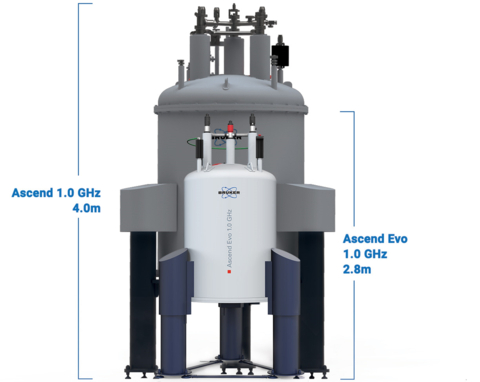UTRECHT, The Netherlands– At the Euromar 2022 Conference, Bruker announced three new customer orders for GHz systems, which will incorporate novel, compact 1.0 GHz NMR magnets for structural biology applications and clinical research in single-story laboratories. The new Ascend Evo 1.0 GHz NMR magnet, operating at 4.2 Kelvin, allows functional structural biology and clinical phenomics researchers to dive deeper into the structural details, binding and dynamics of molecular structures and complexes for fundamental cell biology and pathobiology research. It complements Bruker’s Avance Neo 1.1 GHz and 1.2 GHz NMR systems with two-story 2 Kelvin magnets, which typically are used at shared national NMR facilities, such as the 1.2 GHz NMR at the Dutch Ultra-high Field Magnetic Resonance Consortium, operating at Utrecht University.
A first new 1.0 GHz NMR order comes from the RIKEN Center for Biosystems Dynamics Research in Yokohama, Japan. The RIKEN team under Dr. Ichio Shimada will use GHz NMR to study dynamical structures of biomolecules in solution and to investigate the relationships between dynamical structures and biological function or pathobiology.
Bruker also confirms two 1.0 GHz NMR orders from major research centers and universities in Bilbao and Barcelona, both in Spain, for clinical and biological research:
Professor Óscar Millet, Principal Investigator of the Precision Medicine and Metabolism Lab at CIC bioGUNE stated: “The Ascend Evo 1.0 GHz will advance our research in clinical metabolomics. This novel magnet provides highest-resolution NMR to investigate the molecular patterns and mechanism of action of prevalent and rare diseases in precision medicine, all in a single-story lab and with a smaller footprint.”
Professor Miquel Pons Valles, Group Leader of the BioNMR Group at Universitat de Barcelona and his team use biophysical methods, especially NMR, as well as chemical biology, molecular biology, and computations to study proteins in regulatory processes, where dynamics is essential for function. The Ascend Evo 1.0 GHz will also advance their research on intrinsically disordered proteins (IDPs).
The recently introduced, compact Ascend Evo 1.0 GHz NMR magnet has significantly reduced footprint, weight, and ceiling height requirements to fit into most single-story laboratories. Along with a 65% reduction in helium consumption, this provides more structural biology principal investigators, individual universities and research centers, as well as advanced biopharma companies access to the sensitivity and resolution of GHz NMR in order to enable new research capabilities.
Another innovation is Bruker’s new Heliosmart Recovery, a compact and easy-to-site system that collects helium boil-off from NMR magnets. Helium gas is stored in high-pressure cylinders, which can be used by cryogen suppliers for reliquification. The Heliosmart Recovery system can collect the steady-state boil-off of several NMR magnets in parallel with typical recovery rates of 80% – 85%.
Dr. Falko Busse, President of the Bruker BioSpin Group, commented: “We are excited to announce the three new GHz orders, which will incorporate our innovative, single-story Ascend Evo 1.0 GHz magnet. This technological marvel brings the power of GHz NMR to more laboratories due to its smaller footprint, reduced maintenance requirements and lower Helium consumption.”


